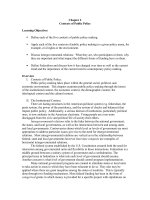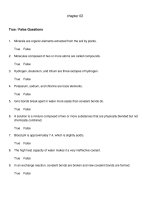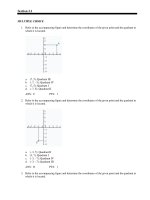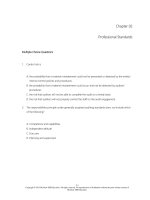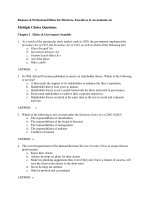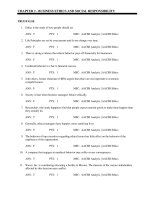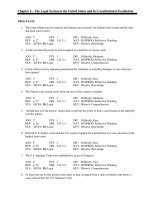Cengage advantage american foreign policy and process 6th edition mccormick test bank
Bạn đang xem bản rút gọn của tài liệu. Xem và tải ngay bản đầy đủ của tài liệu tại đây (275.7 KB, 8 trang )
CHAPTER 2
America’s Global Involvement and the Emergence of the
Cold War
MULTIPLE CHOICE
1. According to the text, key reasons for abandoning isolationism by the United States after World
War II included
a. a changing attitude toward global involvement by Presidents Franklin Roosevelt and Harry
Truman and their advisors.
b. the fear that Britain under Winston Churchill was seeking to assert global power at
American expense.
c. the economic and political vacuum that existed generally in central Europe and global
politics.
d. the successful revolution in China by Chiang Kai-shek.
e. Both options A and C are true.
ANS: E
REF:
34, 35, 38
NOT: Conceptual
2. According to the text, which city did NOT bear the “scars of war” after World War II?
a. London
b. Vienna
c. New York
d. Berlin
e. Cologne
ANS: C
REF:
35
NOT: Factual
3. President Roosevelt’s global blueprint design for ending World War II and for the postwar world
envisaged all of the following except
a. the total defeat and disarming of adversaries.
b. a concerted effort to prevent future global economic depression and to foster selfdetermination for all states.
c. the reversion to isolationism by the United States.
d. the establishment of a collective global security organization.
e. the initiation of the “Four Policeman” concept to maintain global order.
ANS: C
REF:
Copyright © Cengage Learning. All rights reserved.
36
NOT: Factual
10 Chapter 2: America’s Global Involvement and the Emergence of the Cold War
4. The view that the behavior of the Soviet Union was much like other nations in defining its interests
and fostering its goals based upon power realities can be described as
a. the “Yalta Axioms.”
b. the “Riga Axioms.”
c. Franklin Roosevelt’s view.
d. George Kennan’s view.
e. Both options A and C are true.
ANS: A
REF:
36
NOT: Conceptual
5. All of the following are steps in the strategy for the division and operation of postwar Europe except
a. zones of German occupation would be created and controlled by Americans, British,
French, and Soviets.
b. the Soviet Union would be denied territory from Poland.
c. the Polish government would be improved by the expansion of the Lublin Committee to
include Polish government officials in exile in London.
d. a Declaration of Liberated Europe was proclaimed.
e. an agreement of the Soviets entry into the war against Japan was created.
ANS: B
REF:
37
NOT: Factual
6. According to the text, Truman’s commitment to continued American involvement in global affairs
after World War II was based upon
a. a commitment to Wilsonian idealism regarding an internationalist role for the
United States.
b. the circumstance of his assuming office after the completion of the Yalta Conference and
his commitment to carrying out Roosevelt’s policies.
c. the view of his closest advisors who promoted an international role for the United States.
d. Both options A and B are true.
e. All of the above are true.
ANS: E
REF:
38
NOT: Conceptual
7. The author of the “Iron Curtain” speech (“from Stettin in the Baltic to Trieste in the Adriatic, an iron
curtain has descended across the Continent”) was
a. George Kennan.
b. Joseph Stalin.
c. Winston Churchill.
d. Harry Truman.
e. Franklin Delano Roosevelt.
ANS: C
REF:
40
NOT: Factual
8. The view that the behavior of the Soviet Union was primarily driven by ideological considerations can
be described as
a. the “Yalta Axioms.”
b. the “Riga Axioms.”
c. Franklin Roosevelt’s view.
d. George Kennan’s view.
e. Both options B and D are true.
ANS: E
REF:
41
NOT: Conceptual
Copyright © Cengage Learning. All rights reserved.
Chapter 2: America’s Global Involvement and the Emergence of the Cold War
11
9. President Truman’s speech to Congress in March, 1947 sought American aid for which two countries
in the Mediterranean region?
a. Iran and Turkey
b. Iran and Greece
c. Greece and Turkey
d. Romania and Turkey
e. Iraq and Turkey
ANS: C
REF:
42
NOT: Factual
10. George Kennan identified all of the following conditions within the Soviet System that would aid the
American policy of “containment” except
a. the population of Russia was physically and spiritually tired.
b. the impact of the Soviet System on the young was unclear.
c. the performance of the Soviet economy had been notably uneven.
d. the Soviet gulag was effectively separating radical socialists from the population.
e. the issue of leadership succession was decidedly incomplete.
ANS: D
REF:
43
NOT: Factual
11. The presidential doctrine usually associated with the emergence of the Cold War is
a. the Truman Doctrine.
b. the Eisenhower Doctrine.
c. the Kennedy Doctrine.
d. the Johnson Doctrine.
e. the Nixon Doctrine.
ANS: A
REF:
43
NOT: Factual
12. Formerly known as the Inter-American Treaty of Reciprocal Assistance, which of the following was
the first regional security pact signed by the United States after World War II?
a. Rio Pact
b. North Atlantic Treaty Organization (NATO)
c. Central Treaty Organization (CENTO)
d. Southeast Asia Collective Defense Treaty (SEATO)
e. ANZUS Treaty
ANS: A
REF:
44
NOT: Factual
13. Which of the following multilateral pacts established in the 1940s and 1950s did not have direct
American membership?
a. Rio Treaty
b. NATO Treaty
c. ANZUS Treaty
d. SEATO pact
e. CENTO Treaty
ANS: E
REF:
Copyright © Cengage Learning. All rights reserved.
44
NOT: Factual
12 Chapter 2: America’s Global Involvement and the Emergence of the Cold War
14. Which of the following collective defense arrangements was unusual as it seemed to call for a
commitment to an automatic armed response to an attack by the signatories?
a. Rio Treaty
b. NATO Treaty
c. ANZUS Treaty
d. SEATO pact
e. CENTO Treaty
ANS: B
REF:
44
NOT: Factual
15. What was the name of the $17 billion economic support program to rebuild the economic system of
Western Europe after WWII?
a. Marshall Plan
b. Point Four Plan
c. Potsdam agreement
d. Treaty of Versailles
e. Lend-Lease Act
ANS: A
REF:
47
NOT: Factual
16. The economic assistance program, announced by President Truman in 1949, to provide industrial,
technological, and economic assistance to the underdeveloped world was known as
a. the Marshall Plan.
b. the Point Four Plan.
c. the Mutual Security Act of 1951.
d. Public Law 480.
e. NSC-68.
ANS: B
REF:
47, 48
NOT: Factual
17. The assistance program that linked American aid and American security and marked the beginning in
the growth of military assistance is known as the
a. Marshall Plan.
b. Point Four Plan.
c. Mutual Security Act of 1951.
d. Foreign Assistance Acts.
e. Truman Doctrine.
ANS: C
REF:
48
NOT: Factual
18. How does the National Security Council document NSC-68 give us a unique picture of the thinking of
American officials towards containment?
a. As it was classified until 1975, officials were unrestrained by the fear of public disclosure.
b. The year 1968 was a significant year wherein policies reified because of the Vietnam War.
c. It was the only document to identify containment as a foreign policy action.
d. It is a rare example of policy makers from the Senate and Congress working together on
foreign policy.
e. It provided an opportunity of viewing containing because it dealt primarily with how to
increase American policy goals in the Pacific Rim—an area rife with ideologically
contested lands.
ANS: A
REF:
50
NOT: Factual
Copyright © Cengage Learning. All rights reserved.
Chapter 2: America’s Global Involvement and the Emergence of the Cold War
13
19. Which of the following policy options was not outlined by the National Security Council document
NSC-68?
a. The continuation of present policies toward the Soviet Union
b. Returning to isolationism on the part of the United States
c. The resort to war against the Soviet Union
d. A rapid buildup of political, economic, and military strength in the Free World
e. De-emphasizing the domestic response to the Soviet threat
ANS: E
REF:
50
NOT: Conceptual
20. The NSC-68 report advanced all of the following arguments except
a. there is a fundamental incompatibility between the United States and the Soviet Union.
b. the Soviet assault on free institutions is worldwide and the United States, in its own
interest, must resist this assault.
c. American defense expenditures were still comparable to the Soviet Union at the time of
the report, but they would become inferior in a few years.
d. the Soviet Union is seeking to undermine America’s social and cultural institutions by
infiltration and intimidation.
e. Both options C and D are true.
ANS: C
REF:
50–52
NOT: Applied
21. Which of the following was not identified in the text as being a direct effect of the Korean War on
American foreign policy?
a. The war resulted in a sharp increase in the American defense budget and the militarization
of NATO.
b. Policy makers recognized the need to maintain large armies as limited wars may
be necessary.
c. The war resulted in confirmation that the Sino-Soviet bloc was a reality and the need to
combat it was a priority.
d. The Cold War Consensus was broken; American policy makers recognized the need for
unilateral actions.
e. Credence was given to NSC-68 and rapid security arrangement changes followed.
ANS: D
REF:
55, 56
NOT: Factual
22. According to the text, what was the first major test of containment, and the event that brought the Cold
War fully into existence?
a. Soviet forces refusing to leave Iran and continuing to meddle in their politics (1946)
b. Soviet pressure on Turkey for control of the Dardanelles (1947)
c. American response to the communist-supported national-liberation movement in Greece
(1947).
d. The signing of the North Atlantic Treaty Organization (1949).
e. The Korean War (1950).
ANS: E
REF:
Copyright © Cengage Learning. All rights reserved.
56
NOT: Applied
14 Chapter 2: America’s Global Involvement and the Emergence of the Cold War
23. The fear of change was expressed in several American military interventions throughout the 1950s and
1960s to prevent Communist gains. Which of the following was not an example of this?
a. The toppling of Prime Minister Mohammed Mossadegh of Iran and the restoration of the
Shah
b. The overthrow of the Jacobo Árbenz Guzmán government in Guatemala
c. The Bay of Pigs invasion of Cuba
d. The Vietnam War
e. The Egyptian–Israeli and Syrian–Israeli disengagement agreements
ANS: E
REF:
58
NOT: Factual
24. Which of the following is a reason for the Sino-Soviet Split?
a. Insufficient technological and economic assistance
b. Disagreement of communist ideals on the part of Mao and Nikita Khrushchev
c. Refusal of the Soviet Union to help China build an independent nuclear force
d. The de-Stalinization movement
e. All of the above are true.
ANS: E
REF:
62, 63
NOT: Factual
25. The nonaligned movement focused its efforts on the
a. desire for independence by colonial territories, especially throughout Asia and Africa.
b. reassembling of the Sino-Soviet split.
c. further fissure between the unified East and unified West.
d. American effort to rally the world against communism.
e. effort to aid American perception towards stability and change.
ANS: A
REF:
65
NOT: Factual
ESSAY
1. According to the text, what are three factors that account for the United States deciding to abandon
isolationism after World War II?
ANS: Answers may vary.
2. As outlined by “Mr. X” in the July, 1947, Foreign Affairs article, what was the overarching goal of
containment ? Who was Mr. X. eventually revealed to be?
ANS: Answers may vary.
3. Identify and briefly describe two regional multilateral politico-military alliances that were established
with United States involvement after World War II.
ANS: Answers may vary.
Copyright © Cengage Learning. All rights reserved.
Chapter 2: America’s Global Involvement and the Emergence of the Cold War
15
4. Explain how America’s dichotomous view of the world came to defining the “Free World” in a notconsistently positive way for the individuals within countries around the globe. What was the unifying
characteristic of the “Free World”?
ANS: Answers may vary.
5. Why were the states in the Free World structure that joined the “Non-Aligned Movement” initiated by
Prime Minister Jawaharlal Nehru of India seen as threatening by policy makers of the United States?
ANS: Answers may vary.
6. How are George Kennan’s “long telegram” and Nikolai Novikov’s telegram similar and what was the
principal implication of each for American-Soviet relations?
ANS: Answers may vary.
7. What was the key argument that Churchill advanced in his “iron curtain” speech in March, 1946, and
how did it differ from Stalin’s speech a month earlier in February, 1946?
ANS: Answers may vary.
8. Explain how the Truman Doctrine set the challenge to the Soviet Union that clearly showed the Cold
War had begun.What were two key American foreign policy prescriptions that it called forth?
ANS: Answers may vary.
9. According to the text, for what two reasons is NATO considered the most important of the Regional
Security Pacts? What is the significance of Article 5 for American policy, and how does this provision
differ from other alliances created after World War II?
ANS: Answers may vary.
10. Identify and discuss two major examples of the economic and military assistance programs that
formed part of the containment strategy. Were these programs successful? Why?
ANS: Answers may vary.
11. What were the policy recommendations of NSC-68 specifically in regards to (a) defense and (b)
internal security? Was NSC-68 a defining document of the Cold War? Give three reasons.
ANS: Answers may vary.
12. What was the origin of the Korean War? Why is it viewed as the first test of containment?
ANS: Answers may vary.
13. What factors combined to communist-bloc breakdown with the Sino-Soviet split? How did historic
rivalries and social-cultural differences contribute to the dispute?
ANS: Answers may vary.
Copyright © Cengage Learning. All rights reserved.
16 Chapter 2: America’s Global Involvement and the Emergence of the Cold War
14. Describe how friction within NATO posed a challenge to the Cold War Consensus. What role did
Charles de Gaulle play to aggravate or soothe tensions?
ANS: Answers may vary.
15. Was there an evident role for “Moral Principle” for America’s policy makers during the Cold War?
Did the containment strategy support or go against the traditional moral values of Americans?
ANS: Answers may vary.
Copyright © Cengage Learning. All rights reserved.
